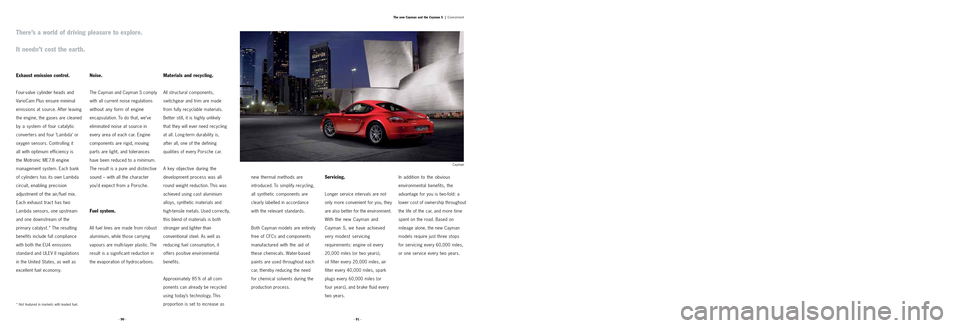air filter PORSCHE CAYMAN 2006 1.G Information Manual
[x] Cancel search | Manufacturer: PORSCHE, Model Year: 2006, Model line: CAYMAN, Model: PORSCHE CAYMAN 2006 1.GPages: 61, PDF Size: 2.24 MB
Page 20 of 61

· 43 · · 42 ·
1
1
6
5
3
10
10
9
8
7
13
12
4
11 2
gearbox is supported laterally by
two additional mounts. All three
mounts are hydraulic in design,
using a fluid-filled element to
dampen vibration and noise. The
mounts are effective against both
high and low-frequency vibration.6. Resonance intake manifold
7. Coolant expansion tank
8. Electronically controlled
throttle valve
9. Connecting duct
10. Silencer11. Connecting tube
12. Oil filler neck
13. Air filter intake duct 1. Radiator module
2. Brake booster
3. Gearshift /gear selector lug
4. PASM damper
5. 6-speed manual gearbox/
5-speed Tiptronic S Engine and gearbox mounts.
Both Cayman models use a
system of three hydraulic mounts
to support the engine and
gearbox. The engine is held by
a single mount located centrally
at the front of the unit. The
The new Cayman and the Cayman S |Drive
Cayman S
Page 44 of 61

· 90 ·
Exhaust emission control.
Four-valve cylinder heads and
VarioCam Plus ensure minimal
emissions at source. After leaving
the engine, the gases are cleaned
by a system of four catalytic
converters and four ‘Lambda’ or
oxygen sensors. Controlling it
all with optimum efficiency is
the Motronic ME7.8 engine
management system. Each bank
of cylinders has its own Lambda
circuit, enabling precision
adjustment of the air/fuel mix.
Each exhaust tract has two
Lambda sensors, one upstream
and one downstream of the
primary catalyst.* The resulting
benefits include full compliance
with both the EU4 emissions
standard and ULEV II regulations
in the United States, as well as
excellent fuel economy.
Noise.
The Cayman and Cayman S comply
with all current noise regulations
without any form of engine
encapsulation. To do that, we’ve
eliminated noise at source in
every area of each car. Engine
components are rigid, moving
parts are light, and tolerances
have been reduced to a minimum.
The result is a pure and distinctive
sound – with all the character
you’d expect from a Porsche.
Fuel system.
All fuel lines are made from robust
aluminium, while those carrying
vapours are multi-layer plastic. The
result is a significant reduction in
the evaporation of hydrocarbons.
Materials and recycling.
All structural components,
switchgear and trim are made
from fully recyclable materials.
Better still, it is highly unlikely
that they will ever need recycling
at all. Long-term durability is,
after all, one of the defining
qualities of every Porsche car.
A key objective during the
development process was all-
round weight reduction. This was
achieved using cast aluminium
alloys, synthetic materials and
high-tensile metals. Used correctly,
this blend of materials is both
stronger and lighter than
conventional
steel. As well as
reducing fuel consumption, it
offers positive environmental
benefits.
Approximately 85 % of all com-
ponents can already be recycled
using today’s technology. This
proportion is set to increase as
* Not featured in markets with leaded fuel.The new Cayman and the Cayman S |
Environment
new thermal methods are
introduced. To simplify recycling,
all synthetic components are
clearly labelled in accordance
with the relevant standards.
Both Cayman models are entirely
free of CFCs and components
manufactured with the aid of
these chemicals. Water-based
paints are used throughout each
car, thereby reducing the need
for chemical solvents during the
production process.
Servicing.
Longer service intervals are not
only more convenient for you, they
are also better for the environment.
With the new Cayman and
Cayman S, we have achieved
very modest servicing
requirements: engine oil every
20,000 miles (or two years),
oil filter every 20,000 miles, air
filter every 40,000 miles, spark
plugs every 60,000 miles (or
four years), and brake fluid every
two years.
In addition to the obvious
environmental benefits, the
advantage for you is two-fold: a
lower cost of ownership throughout
the life of the car, and more time
spent on the road. Based on
mileage alone, the new Cayman
models require just three stops
for servicing every 60,000 miles,
or one service every two years.
· 91 ·
There’s a world of driving pleasure to explore.
It needn’t cost the earth.
Cayman